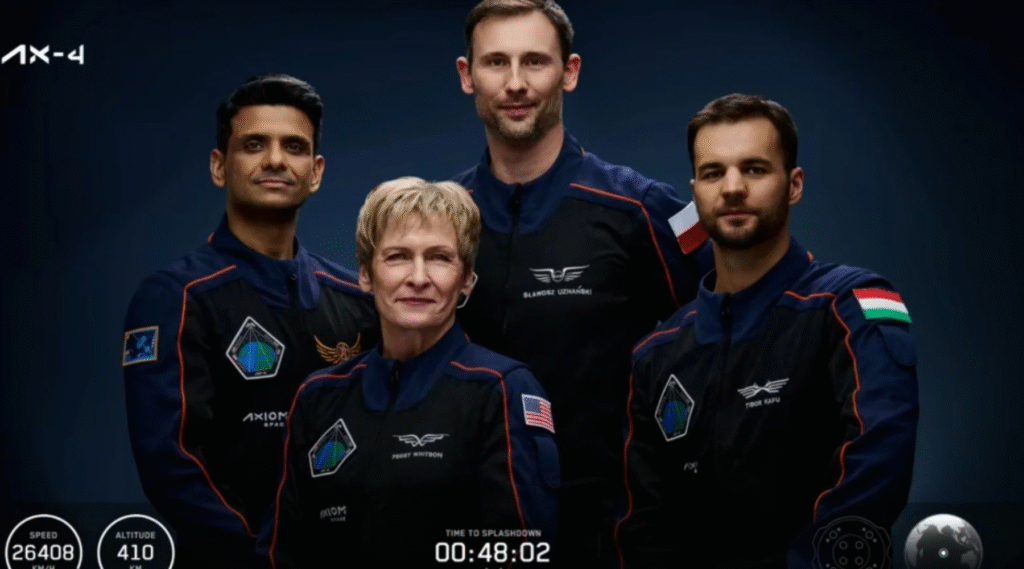Shubhanshu Shukla’s Historic ISS Mission
Group Captain Shubhanshu “Shux” Shukla of the Indian Air Force (IAF) safely returned to Earth on July 15, 2025, after completing an 18-day mission aboard the International Space Station (ISS) as the mission pilot of Axiom Mission 4 (Ax-4). The SpaceX Crew Dragon capsule Grace splashed down in the Pacific Ocean off the coast of California, concluding a milestone private mission. This mission marked India’s first human presence on the ISS and only the second time an Indian citizen has ventured into space, following Rakesh Sharma’s historic flight in 1984.
In orbit, Shukla shared live updates with India. He beamed that “it’s an amazing ride” and marveled at the flag (“Tiranga”) on his suit, telling fellow countrymen, “Namaskar, my dear countrymen! What a ride!… This journey of mine is not a beginning to the ISS but to India’s Human Space Programme… Together, let’s initiate India’s Human Space Programme. Jai Hind! Jai Bharat! These first words from space underscored the historic nature of the flight.
Axiom Mission 4 Timeline and Highlights
Ax-4 lifted off on a SpaceX Falcon 9 rocket from NASA’s Kennedy Space Center on June 25, 2025, at 06:31 UTC. The Crew Dragon Endurance carried the four-person international crew into orbit. After about 14 hours, the spacecraft docked with the ISS on June 26, 2025. In a welcoming ceremony aboard the station, Commander Whitson presented Shukla with an astronaut pin as the 634th person to reach space. Over the next 18 days, the crew lived and worked aboard the ISS, conducting dozens of scientific experiments and exchanging views with mission control.
Key mission steps included:
- Docking at ISS: Endurance automatically docked with the ISS on June 26, 2025 (10:31 UTC), and the crew entered the station at 12:14 UTC.
- Orbital Research: Shukla performed a wide range of experiments (see below) and took part in public outreach (talks with students and Prime Minister Modi via video link) while circling Earth ~16 times a day at over 28,000 km/h.
- Undocking and Re-entry: On July 14, the Dragon undocked from the ISS (at 07:15 EDT) to begin the return flight. The next day, Grace performed an 18-minute de-orbit burn, jettisoned the service section, and deployed parachutes to slow its descent. At 2:32 a.m. PDT (0932 GMT) on July 15, Grace splashed down safely in the Pacific off San Diego. Recovery teams retrieved the capsule by 3:37 pm IST, and the crew was brought aboard the ship for medical checks.
During the mission’s 18-day stay on the ISS, Shukla conducted over 60 scientific experiments, many developed by Indian research institutions. These experiments focused on key domains:
- Agricultural science: Growth of Indian staple crops in microgravity
- Biology & microbiology: Oxygen generation using algae and microbes
- Human physiology: Studies of muscle loss, cognition, and stress in microgravity
- Advanced technology: Brain-computer interfaces, and testing of tardigrade resilience in space
These findings are expected to aid ISRO’s development of long-term life support, habitat systems, and crew health protocols for Gaganyaan and future interplanetary missions.
Shubhanshu Shukla – Background and Career
Born on October 10, 1985, in Lucknow, Uttar Pradesh, Shubhanshu Shukla completed his early education at City Montessori School. He graduated from the National Defence Academy (NDA) Khadakwasla in 2005 and later pursued a Master’s in Aerospace Engineering from the Indian Institute of Science (IISc), Bengaluru.
As a Group Captain and test pilot in the IAF, Shukla has flown over 2,000 hours on various aircraft. Known for his calm composure and technical precision, he emerged as a top candidate for India’s human spaceflight training.
In 2019, he was selected by ISRO and underwent extensive training at Russia’s Yuri Gagarin Cosmonaut Training Center and ISRO’s astronaut training facility in Bengaluru. On February 27, 2024, Shukla was officially named one of four astronauts known as Gaganyatris for India’s upcoming Gaganyaan mission.
Family and Personal Life
Shukla is married to Dr. Kamna Mishra, a dentist and his childhood classmate. Together, they have a son. During his mission, Kamna and his family were frequently seen in the media, proudly following his updates and celebrating his return. Emotional images of his parents waving the Indian flag as he emerged from the capsule captivated the nation.
National Applause and Future Vision
President Droupadi Murmu, ISRO officials, and top scientists praised the success of Ax-4. ISRO Chairman stated:
“This was one small step in orbit, but a giant leap in India’s pursuit of human spaceflight.”
Shukla’s role is far from over. He is widely expected to be a lead astronaut in the Gaganyaan program, India’s indigenous mission to send humans into low-Earth orbit aboard an Indian-made spacecraft. In interviews post-mission, he expressed:
“Returning home is just the first step. I look forward to paving the way for many more Indians in space.”
Group Captain Shubhanshu Shukla’s flight has set a powerful precedent for India’s space future, bridging legacy with aspiration, and transforming India’s dream of space exploration into a reality poised to reach Mars and beyond.
Inspired by Shubhanshu’s journey?
Share this story with your network and celebrate India’s leap into space!
Leave a comment: What does India’s space future look like to you?
